I am playing around with divergence metrics, and I found that if I implement the calculations on my own or rely on the built-in libs, I get two different numbers. Now, I don't know what am (is) I (the built-in function) doing wrong.
For simple analysis, I came up with the following toy example in Python:
import numpy as np
import pandas as pd
#two arrays of "events"
p=np.array([1,2,2,3,5,4,2,3,2,3,4,2,1,1,1,2,2,3,5,4,2,3,2,3,4,2,1,1,1,2,2,3,5,4,2,3,1,1,2,3,4,2,1,1,1,2,2,2,2,1,2,2,3,5,4,2,2,1,2,2,3])
q=np.array([2,3,2,4,2,3,2,3,2,3,2,3,2,2,2,2,1,2,2,3,5,4,2,3,1,1,2,3,4,2,1,1,1,2,2,3,5,4,2,3,1,1,2,3,4,2,1,1,1,2,2,2,2,1,2,2,3,5,4])
I was told that since I will be comparing the two PDF and calculating divergence metrics for them, the "sample space" for each of them should be the same. Hence, I take all possible values taken by both p and q and use that to calculate the PDFs.
This is my simple function to calculate PDF for an array of data in an array of sample space:
def create_prob_dist(data: np.array, sample_space: np.array):
#number of all events
sum_of_events = sample_space.size
#get the counts of each event via pandas.crosstab()
data_counts = pd.crosstab(index='counts', columns=data)
#create probabilities for each event
prob_dist=dict()
for i in sample_space:
if i in data_counts:
prob_dist[i]=(data_counts[i]['counts'])/sum_of_events
else:
prob_dist[i]=0
return prob_dist
To calculate the PDFs with the function, I do these steps:
#get all possible discrete events from p and q
px=np.array(list(set(p))) #we use set here to remove duplicates
qx=np.array(list(set(q))) #we use set here to remove duplicates
#create all possible discrete events of both p and q
mx=np.concatenate([px,qx]) #concatenate first
mx=np.array(list(set(mx))) #remove duplicates
mx.sort() #then sort
#create true PDFs of p and q using mx
p_pdf=create_prob_dist(p, mx)
q_pdf=create_prob_dist(q, mx)
#get the probability values only from the dictionary
p_pdf=np.array(list(p_pdf.values()))
q_pdf=np.array(list(q_pdf.values()))
Then, I can plot the PDFs and the results are in line with my expectations:
plt.figure()
plt.plot(mx, q_pdf, 'g', label="Q")
plt.plot(mx, p_pdf, 'r', label="P")
plt.legend(loc="upper right")
plt.show()
So, once I have the PDFs and also view them, I have a sense of what I would expect from a divergence calculation. In fact, in this case, we should expect something much closer to 0 than 1.
KL divergence
I followed the equation of KL divergence as this:
Accordingly, I created this simple function:
def KL_divergence(P:np.array, Q: np.array):
KL=0
for i,x in enumerate(P):
if ((Q[i] != 0) and (x != 0)): #avoid dividing with 0 and avoid having 0 in math.log()
KL += x * math.log(x / Q[i])
return KL
Note, in my case, P and Q are already prepared well (meaning they were calculated with the same sample space)
I compared my calculation with built-in functions:
from scipy.special import kl_div,rel_entr
print("KL divergence of p and q : {}".format(KL_divergence(p_pdf,q_pdf)))
kl_divergence=kl_div(p_pdf,q_pdf)
print("KL divergence (lib) of p and q : {}".format(sum(kl_divergence)))
print("KL divergence (lib2) of p and q: {}".format(sum(rel_entr(p_pdf, q_pdf))))
and I get the following output:
KL divergence of p and q : 0.4900499180923177
KL divergence (lib) of p and q : 0.09004991809231755
KL divergence (lib2) of p and q: 0.4900499180923177
The rel_entr() gives the same metric as mine, but the kl_div() gives something totally different.
What do you think? Which one is the right one and why?
JS divergence
Since JS divergence is a normalized/balanced version of KL divergence, I also calculated that and compared it to built-in functions.
I found two slightly different definitions. One is just doing a bi-directional KL divergence comparison and getting the average.
The other one, from Wikipedia, uses a mixture distribution as well described as

Accordingly, I have the following implementations for JS (using my KL functions)
#the simple JS
def JS_divergence(P:np.array, Q:np.array):
KL_P_Q=KL_divergence(P, Q)
KL_Q_P=KL_divergence(Q, P)
JS=(KL_P_Q+KL_Q_P)/2
return JS
# Wikipedia version
def mod_JS_divergence(P:np.array, Q:np.array):
#create M
M=(P+Q)/2 #sum the two distributions then get average
KL_P_Q=KL_divergence(P, M)
KL_Q_P=KL_divergence(Q, M)
JS=(KL_P_Q+KL_Q_P)/2
return JS
And this is the code to get the results, which include the use of the built-in function too.
from scipy.spatial.distance import jensenshannon
print("JS divergence of p and q : {}".format(JS_divergence(p_pdf,q_pdf)))
print("mod JS divergence of p and q : {}".format(mod_JS_divergence(p_pdf,q_pdf)))
js_divergence=jensenshannon(p_pdf,q_pdf)
print("JS divergence (lib) of p and q : {}".format(js_divergence))
output:
JS divergence of p and q : 0.08763662020764684
mod JS divergence of p and q : 0.021872274274735898
JS divergence (lib) of p and q : 0.041044079757403054
I am more concerned now about my JS divergence calculations as none of my functions return the same outcome as the built-in one.
My question is again the same: what am I doing wrong? what is the way the built-in function differs from my calculations? Do you guys have any idea?


